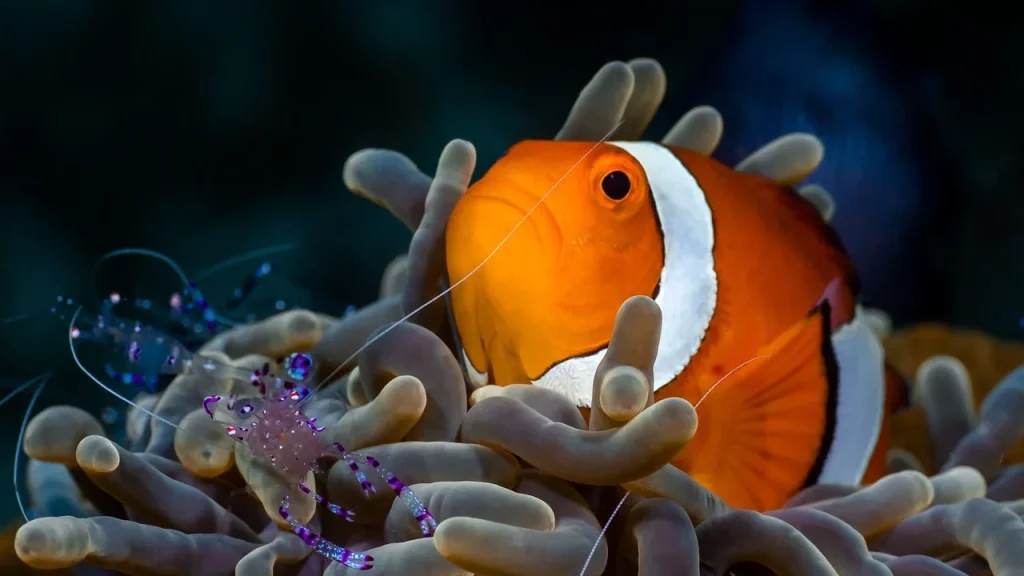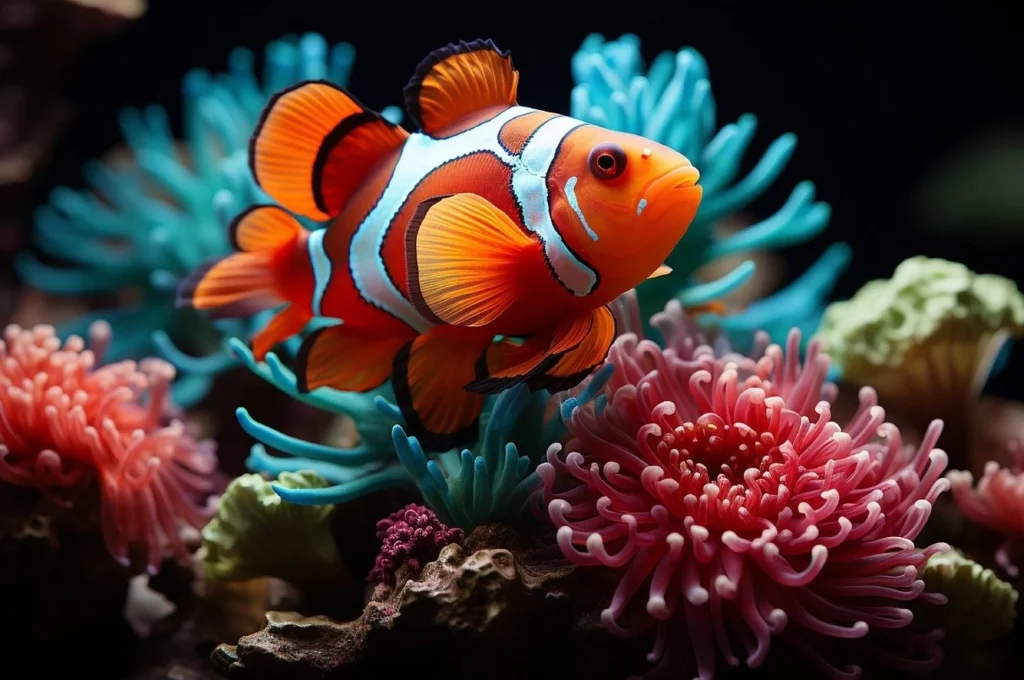Step right up to the greatest show beneath the waves: the enchanting world of clownfish. These small but mighty fish have captivated the hearts of marine enthusiasts and moviegoers alike, but their real lives are even more intriguing than fiction. Navigating through coral reefs and forming unlikely alliances with sea anemones, clownfish are the ultimate survivors in a sea of predators.
But did you know they also have a knack for interior design, rearranging their anemone homes to suit their comfort? It’s true, proving that size isn’t everything in the vast ocean. Ready to dive deeper and discover what other surprises these colorful characters hold?
Clownfish remind us that even in the vast and mysterious ocean, playfulness finds its place.
Unknown
Clownfish Facts
Prepare to be surprised by their secret lives and shocking transformations. Read carefully because I created a quiz for you at the end of this page to test your knowledge of them.
- These fish are capable of changing their sex from male to female, a process known as sequential hermaphroditism.
- In their habitats, often among anemones, they exhibit a mutualistic relationship, gaining protection from predators and providing food scraps in return.
- Their vibrant colors serve as a warning to potential predators about their toxic anemone hosts.
- They have a unique adaptation that allows them to be immune to the stings of the anemones they live with.
- Symbiodinium, a type of algae, lives within their skin, contributing to their coloration and the mutual benefit of both organisms through photosynthesis.
- Not all species have a bold orange color; some exhibit shades of black, yellow, maroon, and more.
- Their populations are found across the Indo-Pacific, with significant diversity on the Great Barrier Reef.
- Their eggs hatch after sunset, timed with the tide, to optimize the survival chances of the larvae.
- These fish are known for their monogamous pairings, often staying with one partner for life.
- The largest member of their family can reach up to 18 centimeters in length, while the smallest barely reaches 10 centimeters.
- They communicate through pops, clicks, and chirps, which can be heard during aggressive interactions or courtship.
- Their lifespan in the wild is about 6 to 10 years, but in captivity, some individuals have lived up to 18 years.
- A group is led by a dominant female, and if she dies, the largest male will change sex to take her place.

- They lay hundreds to thousands of eggs at a time, which are attached to flat surfaces and guarded by the male.
- Climate change and rising sea temperatures pose a threat to their survival, affecting their symbiotic algae.
- They have a slimy mucus covering their bodies, which protects them from the stinging nematocysts of anemones.
- In the absence of suitable anemones, they can form symbiotic relationships with other species of soft corals or large polyps.
- Interestingly, they can recognize themselves in mirrors, a trait indicating a level of self-awareness.
- They exhibit a preference for certain types of anemones, with some species only associating with specific anemone species.
- Their diet mainly consists of algae, zooplankton, and small invertebrates.
- Despite their peaceful appearance, they can be quite territorial, especially when defending their anemone homes.
- Their swimming motion is characterized by a series of rapid, darting movements, making them agile within their anemone shelters.
- Overfishing for the aquarium trade has led to declines in certain populations, highlighting the need for sustainable practices.
- They are capable of night vision, which helps them avoid predators and navigate in the dark.
- Their eggs are coated in toxic mucus to deter predators from eating them before they hatch.
- Aquarium enthusiasts often face challenges in replicating their complex habitat requirements for long-term health.
- Research has shown that they can adjust their sleeping patterns based on the lunar cycle.
- They are known to form cleaning stations for turtles, removing parasites from their skin.

- Global warming threatens their anemone homes, leading to bleaching events that can be fatal to both species.
- Some species have been observed engaging in playful behavior, such as bouncing around their anemone.
- Their social structure within an anemone can be quite complex, with a clear hierarchy among the group.
- They have a keen sense of smell, which they use to navigate and recognize members of their species.
- Protection efforts for their habitats include marine reserves and restrictions on aquarium trade collections.
- Their larvae drift in the ocean currents for several weeks before finding and settling in a suitable habitat.
- Environmental pollutants can disrupt their sense of smell, affecting their ability to find food and avoid predators.
- Interestingly, not all anemone species are suitable hosts, with some being lethal to them.
- They play a critical role in their ecosystem, contributing to the biodiversity and health of coral reefs.
- Scientific studies have used them as model organisms to understand coral reef ecosystems and climate change impacts.

- Advancements in aquaculture have led to successful breeding programs, reducing pressure on wild populations.
- Their color patterns are not just for display; they help in camouflage among the tentacles of their host anemones.
- They can experience stress if exposed to constant light or noise, showing the need for careful aquarium management.
- While generally peaceful, they can exhibit aggressive behavior towards other tankmates if they feel threatened or cramped.
- Conservationists advocate for the use of tank-bred individuals over wild-caught to preserve natural populations.
- They are sensitive to changes in water quality, requiring stable conditions to thrive in captivity.
- Their presence in an ecosystem indicates a healthy coral reef environment, serving as a barometer for reef health.
- Unique genetic adaptations allow them to tolerate a wide range of temperatures and salinity levels in their natural habitat.
- Recent studies suggest they can adapt to increased acidity levels in the ocean, offering hope for their resilience to climate change.
- Their breeding season is influenced by the moon cycle, with peak spawning occurring around the full moon.
- They are capable of recognizing and distinguishing between different human faces, a rare ability in fish.
- Despite their association with certain anemones, they can exhibit flexibility in host choice when their preferred anemone is not available.
Clownfish Myths

Time to separate truth from fishy tales! Dive into some wild myths and see the actual truth behind them.
- Clownfish Can Change Gender at Will
They are all born male, and the ability to change gender is not at will but a fascinating aspect of their social hierarchy. When the dominant female of a group dies, the largest male is then transformed into a female to take her place. - Clownfish Can Live in Any Tropical Waters
It is often assumed that they can thrive in any warm sea. However, their distribution is primarily limited to the shallow waters of the Indian Ocean, the Red Sea, and the Pacific Ocean, where specific types of anemones, essential for their survival, are found. - Clownfish Spend Their Entire Lives in a Single Anemone
While they are known for their strong association with specific anemones, the belief that they never venture out is exaggerated. For feeding and spawning, they are occasionally observed to stray but always return to their host anemone. - Clownfish Are Always Orange
The common perception that all clownfish sport orange hues is a simplification. In reality, their coloration ranges widely, including shades of yellow, red, black, and more, depending on the species and their specific environments. - Clownfish and Anemones Share a One-Sided Relationship
The relationship between them and their anemone hosts is often misconceived as purely beneficial for the fish. However, this symbiotic relationship is mutual; they clean the anemone and provide nutrients via their waste, contributing to the health and growth of their hosts.
No products found.
Clownfish FAQ

We are one step away from the quiz. Read carefully the following FAQs if you want to have a higher chance of getting a perfect score.
- Are clownfish aggressive?
Absolutely! While they’re small and colorful, they can be quite feisty, especially when protecting their home or anemone. They’re known to nip at fish, or even divers, who get too close to their territory. - What do clownfish eat?
They are not picky eaters. In the wild, their diet mainly consists of small zooplankton, algae, and tiny crustaceans. In aquariums, they’re usually happy with a mix of meaty foods and algae-based meals. - Are clownfish poisonous?
No, clownfish themselves are not poisonous. However, their home, the sea anemone, is. They have a special mucus coating that protects them from the anemone’s stinging cells, allowing them to live together in a symbiotic relationship. - Can clownfish survive in freshwater?
They need saltwater to thrive. They are marine fish, and putting them in freshwater can be harmful to their health. They rely on the stable conditions that saltwater provides for their physiological processes. - Are clownfish endangered?
Most of their species are not currently considered endangered. However, their populations are affected by habitat loss, climate change, and the aquarium trade. It’s essential to practice sustainable aquarium keeping and support coral reef conservation efforts to ensure their future.
Clownfish Trivia

Dive into the clownfish quiz, where the only thing more colorful than the questions is the possibility of being turned into a human-sized anemone if you score zero. Brace yourself for a splash of humor and a wave of facts!
Conclusion
So, we’ve spent some time getting to know clownfish, and honestly, they’re just the coolest little dudes in the sea. They’re not only about bright colors and adorable faces; these fish have got a whole symbiotic relationship thing going on that’s like the ultimate roommate setup.
Imagine living with someone who lets you eat leftovers and protects you from bullies—that’s basically what they’ve got! Every time you see a clownfish, remember, there’s a whole epic saga of survival and teamwork happening right there. Till next time, stay curious. Cheers.


